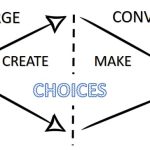Design thinking involves two types of thinking, viz. convergent thinking and divergent thinking. One needs to think of many solutions to a common problem statement and then arrive at the correct and the best solution.
Divergent thinking is the process of devising more than one solution for a problem statement. It refers to the thought process of generating creative solutions. The main features of divergent thinking are −
● It is a free flowing chain of ideas.
● It happens in a non-linear manner, i.e. it does not follow any particular sequence of thinking. Moreover, multiple ideas can emerge at the same time, rather than one idea coming up only after the other has occurred.
● Non-linearity also means that multiple solutions are thought of and explored at the same time. This happens in a very short amount of time and unexpected connections are developed between the ideas.

A stimulus is provided to the design thinker and that prompts creative elaboration of ideas by the thinker.
Divergent thinking is supposed to enhance creativity of thinkers. The term ‘Divergent Thinking’ was first coined by J. P. Guilford in 1956. The Free Association Theory of Creativity says that concepts are connected inside our brains as semantic networks. Psychologists have claimed that the difference in creativity levels of people is dependent on the type of semantic networks of concepts inside the human mind. Following are the two types of connections −
● Flat
● Steep
The design thinkers with flat networks are those with numerous loose conceptual connections. They are more creative. The people with steep networks are more logical, because of the linear associations between the nodes. Because divergent thinking proceeds in a non-linear fashion, a person with flat associative network will be more successful in divergent thinking.
Before getting into the exercise of design thinking, a person has to find out what type of thinker the person is. If a person can think of diverse solutions, without any pre-determined set of solutions, then the person is a divergent thinker. Let’s take a look at an exercise on divergent thinking.
Case Study
Problem Statement − The process of knowledge transfer is a huge problem for the organization. Let’s call our organization ‘DT’. DT wants to eliminate the overhead of shelling out extra money and investing time for transferring knowledge to its new employees. The problem statement at hand is “Knowledge transfer adds to the cost of the company”. Let’s think of ways to eliminate or at least, reduce the cost to the company.
Solution − Following can be some of the possible and even not-so-possible solutions.
● DT can eliminate the process of knowledge transfer.
● DT can conduct classroom sessions for knowledge transfer, where a large number of new employees can be seated and just one instructor can deliver sessions to many employees at once. This will reduce the cost as the number of paid instructors required will be less.
● DT can come up with a document for knowledge transfer and can mail it to every new employee. The employees can go through the document and hence, can selfhelp for knowledge transfer.
● DT can ask the employees to search for material online to gain knowledge of new tools and processes, which are currently in use in the industry.
● DT can hire only those employees who have adequate knowhow of tools and techniques that DT works on. This will eliminate the need of knowledge transfer.
There may be many other solutions that may come to your mind. Write them down on a sheet of paper. Here, we won’t focus on whether a solution is possible, feasible or viable. We just need to bring ideas to the table, no matter how absurd they may sound. This is called the process of divergent thinking, where a thinker is free to move or flow in any direction.


